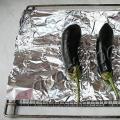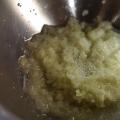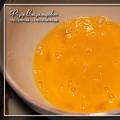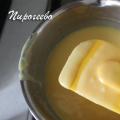Canned solyanka with mushrooms for the winter- This is not only an amazing dish with amazing taste, but also an excellent snack that all practical housewives prepare for the cold weather. There are many recipes for preparing this treat with different interpretations and additives. Traditional Russian rolls certainly include cabbage, mushrooms; and has not lost its popularity for a long time. Harvesting solyanka does not take long and consists of several completely simple steps. You can get acquainted with the methods of making this winter vegetable delicacy in the following interesting and, most importantly, proven recipes.
Classic solyanka recipe for the winter

“Hodgepodge with honey mushrooms and herbs”
Ingredients for the next version of the winter twist " Solyanka with mushrooms is delicious for the winter" will become: 0.5 kg of honey mushrooms, 2 kg of fresh white cabbage, 0.5 kg of onions, 1 kg of bell pepper, 100 g of parsley, half a glass of sunflower oil, 1 glass of vinegar 9%, salt, spices (bay leaf, black pepper and sweet peas, cloves).
Honey mushrooms, thoroughly cleared of debris and thoroughly washed, are dipped in salted water, boiled and boiled for about 30 minutes. In this case, you should regularly remove the foam from the surface. The water is drained from the cooked mushrooms and they are left to cool. The head of cabbage is finely shredded. The greens crumble finely. Sweet peppers are cut into strips, and onions are cut into neat cubes. Oil is poured into a deep frying pan and heated, and chopped onion is fried in it until slightly translucent. The onions are followed by cabbage and sweet peppers. After stirring, the mixture is fried in an open container for 7-8 minutes, and then salted, peppered, seasoned with parsley and mixed again.

Then half a glass of raw water is added to the vegetable mixture, the pan is covered with a lid, and the dish is simmered over low heat for 15 minutes. Next, add 3 bay leaves, 4 buds of cloves, 3-4 peas each of black and allspice. The mixture is stirred and simmered for another 5 minutes. The hot solyanka is placed in 1-liter glass jars, covered with lids and sterilized in boiling water for half an hour. After the thermal procedure, the jars are rolled up, the lids are turned down and covered with something warm. The cooled seaming “ ” should be transferred to a cool room for long-term storage.

Solyanka with mushrooms is an excellent preparation for the winter. This is one of the few preparations that I make every year. The required ingredients for solyanka are mushrooms and cabbage. I also add bell pepper. Solyanka prepared according to this recipe turns out juicy, aromatic, and very filling. I serve it very often as a side dish for meat and fish dishes. But solyanka with mushrooms on fresh rye bread is especially good as a snack.
You can use any mushrooms; I’m not a mushroom picker, so I prefer to use tried and true oyster mushrooms. You can use fresh tomatoes, tomato puree or tomato paste.
To prepare hodgepodge with mushrooms for the winter, we will need the following products: cabbage, oyster mushrooms, carrots, onions, bell peppers, tomato paste, vegetable oil, water, salt, sugar, bay leaf, allspice, vinegar.
Shred cabbage and carrots on a shredder. Cut the bell pepper into small cubes, first removing the seeds from the pepper.

Pour half the amount of vegetable oil specified in the recipe into the frying pan, heat the frying pan and fry the vegetables until soft for 5-10 minutes.

Meanwhile, cut the mushrooms and onions into small cubes. If you like the mushrooms to feel brighter in the hodgepodge, you can chop them larger.

Boil the mushrooms in a pan of salted water for 5-7 minutes. Place them in a colander and let the water drain.

Pour the remaining vegetable oil into another frying pan, put the frying pan on the fire and fry the onions and mushrooms until the onions are soft, 5-8 minutes.

Combine vegetables and mushrooms with onions in a common frying pan. Add sugar, salt, bay leaf, allspice.

Add tomato paste or tomato puree. If you add tomato puree, you should use twice as much as tomato paste.

Pour water into the pan and simmer the hodgepodge over low heat under the lid for 30-40 minutes, stirring occasionally, until the liquid has evaporated and you get a thick hodgepodge. Add vinegar and let the hodgepodge boil for another 2-3 minutes.

Place the hot hodgepodge with mushrooms in sterilized jars and seal tightly with lids. For the winter, hodgepodge with mushrooms should be stored in a cool place, preferably in the basement.

How great it is to open a jar of solyanka with mushrooms in winter and enjoy the wonderful taste!
Sakura is most often associated with Japan and its culture. Picnics under the canopy of flowering trees have long become an integral attribute of welcoming spring in the Land of the Rising Sun. The financial and academic year here begins on April 1, when the magnificent cherry blossoms bloom. Therefore, many significant moments in the life of the Japanese take place under the sign of their flowering. But sakura also grows well in cooler regions - certain species can be successfully grown even in Siberia.
We have prepared a hearty, incredibly appetizing and simply easy-to-prepare dish for you today. This sauce is one hundred percent universal, as it goes with every side dish: vegetables, pasta, or anything. Chicken and mushroom gravy will save you in moments when you don’t have time or don’t want to think too much about what to cook. Take your favorite side dish (you can do this in advance so everything is hot), add some gravy and dinner is ready! A real lifesaver.
Agriculture is one of those types of human activity, the successful outcome of which is not always directly proportional to the efforts made. Unfortunately, nature does not necessarily act as our ally when growing plants, and often, on the contrary, even throws up new challenges. Increased reproduction of pests, abnormal heat, late return frosts, hurricane winds, drought... And one of the springs gave us another surprise - a flood.
With the arrival of the dacha season, the question arises of growing strong and healthy seedlings of our favorite vegetables: cabbage, tomatoes, sweet peppers, eggplants and many other crops. At the same time, the question arises - how to grow decent seedlings and subsequently get healthy plants and a decent harvest from them? For example, I have been growing seedlings for several seasons now and protecting my garden from diseases with the help of biological preparations Alirin-B, Gamair, Glyokladin, Trichocin.
Let me confess my love today. In love with... lavender. One of the best unpretentious, evergreen and beautifully flowering shrubs that can be successfully grown in your garden. And if anyone thinks that lavender is a Mediterranean or at least southern resident, then you are mistaken. Lavender grows well in more northern regions, even in the Moscow region. But to grow it, you need to know some rules and features. They will be discussed in this article.
Once you have tried such an invaluable product as pumpkin, it is difficult to stop searching for new recipes for serving it to the table. Korean pumpkin, despite its pungency and spiciness, has a fresh and delicate taste. After cooking, you will need to cover the salad and let it sit for at least 15 minutes. My nutmeg pumpkin is very juicy and sweet, so there is no need to mash it. If the pumpkin is of a different variety, you can mash it with your hands so that it slightly releases the juice.
Lettuce, as the earliest and most unpretentious green crop, has always been held in high esteem by gardeners. Most gardeners usually start spring planting by sowing lettuce, parsley and radishes. Recently, the desire for healthy eating and a large selection of greens in supermarkets have forced gardeners to think about which of these plants can be grown in their beds? In this article we will talk about nine of the most interesting, in our opinion, varieties of salad.
The flowering of indoor roses always comes with one more “bonus” - capriciousness. When they say that it is easy to grow roses in rooms, they are lying. For indoor roses to bloom, you need to create literally ideal conditions. And constant care, attention and response to any plant signals is the main key to success. True, no matter how capricious roses may be, they can be grown quite successfully in a potted format. And attentive flower growers should not be afraid of this.
Pollock is best prepared as a casserole, separating the fillet from the skin and bones. Pieces of fish are mixed with a colorful assortment of vegetables and topped with a sauce of cheese, sour cream and eggs. This fish casserole has a presentable appearance, and its taste is a bizarre mixture of subtle nuances. Vegetables and fillets will be soaked in sour cream, the cheese will harden into a golden brown crust, and the eggs will bind all the ingredients together. Pieces of fish are generously sprinkled with Italian herbs, and pollock acquires an unusual piquancy.
Despite the fact that calendar spring begins in March, you can truly feel the awakening of nature only with the appearance of flowering plants in the garden. Nothing signals the arrival of spring as eloquently as clearings of blooming primroses. Their appearance is always a small celebration, because winter has receded and a new gardening season awaits us. But, besides spring primroses, there is still something to see and admire in the garden in the month of April.
Rapidly growing and turning into wild thickets, hogweed disrupts the existing ecosystem and suppresses all other plants. Essential oils contained in the fruits and leaves of hogweed cause severe forms of dermatitis. At the same time, it is much more difficult to control than other common weeds. Fortunately, today a product has appeared on the market that can quickly rid your area of most weeds, including hogweed.
Carrots come in different colors: orange, white, yellow, purple. Orange carrots are dominated by beta-carotene and lycopene, the yellow color is due to the presence of xanthophylls (lutein); White carrots have a lot of fiber, and purple ones contain anthocyanin, beta and alpha carotenes. But, as a rule, gardeners choose carrot varieties for sowing not by the color of the fruit, but by the timing of their ripening. We will tell you about the best early, middle and late varieties in this article.
We recommend a fairly easy pie recipe with a delicious chicken and potato filling. An open pie with chicken and potatoes is an excellent hearty dish that is suitable for a hearty snack; it is very convenient to take a couple of pieces of this pastry on the road. The pie is baked in the oven for one hour at 180 degrees. After this, we lay it out on a wooden surface, having first released it from the mold. It is enough to slightly cool the baked goods and you can start tasting.
The long-awaited spring for many indoor plants is the period of the start of active growing season, and for most - the return of their decorative properties. While admiring the young leaves and emerging shoots, you should not forget that spring is also a great stress for all indoor plants. Sensitive to changes in conditions and universal, all indoor crops face much brighter lighting, changes in air humidity and temperature conditions.
You can easily prepare homemade Easter cake with cottage cheese and candied fruits, even without any pastry experience. You can bake Easter cake not only in a special form or in a paper mold. For your first culinary experiences (and more), I advise you to take a small cast-iron frying pan. Easter cake in a frying pan will not turn out as high as in a narrow pan, but it never burns and is always well baked inside! Cottage cheese dough made with yeast turns out airy and aromatic.
Mushroom solyanka with cabbage and vegetables for the winter
Mushroom solyanka with vegetables– a wonderful, satisfying and tasty snack for any occasion. But this is not just a tasty dish, it is also a healthy food that both adults and children love.
Preparation of mushroom solyanka will not take much time, will not take away energy and money. All products for this dish are cheap, and mushrooms are gifts from the forest; you can always pick them up in the forest completely free of charge during the season. And what a taste and aroma it is, you'll just lick your fingers.
Do you want to make your own fragrant and satisfying preparation at home? Pay attention to our simple recipe for mushroom hodgepodge for the winter.
Mushroom solyanka with cabbage, made according to our recipe, is suitable as a main dish, which can be served with bread (black, white), as an appetizer, as an addition to some kind of side dish.
Let's talk about how to cook mushroom solyanka with vegetables right now. So, mushroom hodgepodge for the winter, what products we take.
 Ingredients for mushroom solyanka
Ingredients for mushroom solyanka To prepare mushroom hodgepodge you will need:
any mushrooms (boiled should be at least 2 kg);
2 kilos of cabbage;
1 kilogram of onions and carrots;
200 ml (measuring cup) classic tomato or mushroom paste;
5-6 pieces of medium-sized bay leaves;
200 ml (glass) refined vegetable oil;
3-4 tablespoons of salt (to your taste);
4-5 tablespoons of sugar (to your taste);
2-3 tablespoons of vinegar (2 – nine percent, 3 – six percent);
ground allspice or peas to your taste - 5-6 peas, 1-2 teaspoons.
How to prepare mushroom solyanka?
Mushroom solyanka recipe for the winter step by step
Mushroom solyanka with cabbage is prepared as follows:
Step 1. The collected mushrooms, preferably if they are gifts of the forest of one type, for example, only boletus mushrooms or only honey mushrooms, should be washed and cleaned of adhering leaves, twigs and dirt.
Attention! Cooking mushroom hodgepodge according to our recipe allows the use of any edible mushrooms, however, the most suitable options for the dish are porcini mushrooms, saffron milk caps, boletuses, honey mushrooms and boletus mushrooms.
Step 2. Cut the peeled and washed mushrooms into a saucepan into medium-sized pieces (not small) - in half, into three, or even into four parts, it all depends on the size of the mushroom; we don’t cut small mushrooms at all.
Step 3. Fill the mushrooms with water until they are completely covered, add a little salt, a pinch is enough, put on the fire and after boiling, cook for 15-20 minutes.
Step 4. Strain the finished boiled mushrooms until the liquid is completely drained and set aside for now.
Step 5. Take a large basin or large saucepan.
Step 6. Finely chop the cabbage into a container. In a basin you should mash it a little and fill it with sunflower oil.
Attention! The recipe for mushroom hodgepodge for the winter allows you to replace vegetable oil with olive oil. If you use olive oil for a dish, choose a product that contains more than 80% olive oil.
Step 7. Place the cabbage on the stove and turn on medium heat. At this time, we clean and grate the carrots on a coarse grater, you can grate the vegetable in Korean (the mushroom hodgepodge with vegetables in this case will look more appetizing).
Step 8. Add the carrots to the cabbage and stir gently with a spatula.
Step 9. Peel the onion and cut it to your taste. You can cut it very finely so that it is not visible later in the finished dish; you can cut it into half rings or halves of half rings. We send it to stew with the vegetables.
Step 10. Take a liter of boiled water, dilute tomato paste in it, pour the mixture over the vegetables, and mix.
Step 11. After 10 minutes, after you have poured tomato juice over the vegetables, add sugar, laurel, pepper, salt to the dish, mix everything again using a wooden spatula.
Step 12. When the vegetables are already boiling, reduce the heat to minimum and simmer for about an hour (45-50 minutes), but no more than an hour.
Step 13. 10 minutes before the end of cooking, after 40 minutes of stewing the vegetables, add boiled mushrooms to them. Stir and let simmer for another 10 minutes.
Step 14. Turn off the heat, cover the hodgepodge with a lid, and leave it like that for 5-7 minutes.
Mushroom solyanka with vegetables is ready, it can be cooled and eaten immediately, or it can be prepared for the winter. To do this, you should sterilize liter or 500 ml bottles in advance. jars, boil the sealing lids, spread the hot mushroom hodgepodge into containers and roll up.
Wrap the rolled cans in towels and let them cool right in the room. When the mushroom hodgepodge has reached room temperature for the winter, it can be stored in a colder place.
Mushroom solyanka with vegetables should be stored at a temperature of +3 to +9 degrees. The shelf life in this case can be up to two years.
Bon appetit!
Great( 4 ) Badly( 0 )
See how easy it is to prepare cabbage soup with mushrooms for the winter. The recipe for a finger-licking delicious vegetable stew made from the most inexpensive and accessible products is already waiting for you below. What could be simpler than cabbage and forest mushrooms, unless, of course, you collect mushrooms in the forest and not at the market.
The dish can be served immediately or placed in jars and sterilized according to the recommendations given in this recipe.
The mushrooms are pre-boiled until tender; the cooking time depends on the variety.
Such preparations are stored only in a cool cellar or basement at a temperature not exceeding +8 degrees Celsius. Please also take a look at this one.
It will take 90 minutes to prepare; from the above ingredients you will get several jars with a capacity of about 0.5 liters.
Ingredients:
- white cabbage – 3 kg;
- forest mushrooms – 1 kg;
- onion – 500 g;
- carrots – 500 g;
- tomato sauce – 250 ml;
- salt – 20 g;
- vegetable oil – 50 ml;
- apple cider vinegar – 25 ml;
- bay leaf, pepper.
Peel the onion and chop finely. In a deep saucepan with a thick bottom, heat the vegetable oil, throw in the onion, add a little salt. Sauté the onion until transparent, stirring so as not to burn. 
Wash the carrots, scrape them, grate them on a coarse grater. Add the grated carrots to the sautéed onion in a saucepan and cook everything together for 10 minutes. 
Cut the stalk from the fork, chop the cabbage thinly, sprinkle with the remaining salt. Grind the chopped vegetables with salt to reduce them slightly in volume, add to the saucepan. 
Then add finely chopped boiled mushrooms and tomato sauce to the vegetables. Cover the saucepan with a lid and simmer over moderate heat for 45 minutes.
It is important to properly boil the gifts of the forest - carefully sort, wash, chop finely, put in a saucepan with water, bring to a boil and drain the first water. Then pour clean boiling water, add salt and cook until tender for about 30 minutes. 
10 minutes before cooking, add black peppercorns, a few bay leaves and apple cider vinegar. I'm sure you'll like this one too. 
We pack the hodgepodge into clean and dry jars, close the lids, and sterilize the 500 ml jars in boiling water for 15 minutes. 




